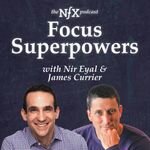Notes and Takeaways from The Psychology of Focus via NFX
When I listened to it: October 2020
Why I listened to it: I’m a semi-regular listener of the NFX podcast. I listened to this episode a while ago, and I liked what the guest Nir Eyal had to say about focus. Nir shares the differences between a habit and a routine and walks through the frameworks from his best-selling books.
Go to the episode page for details and to listen or scroll down to review my notes.
Want to get my future notes when I publish them? Subscribe to my weekly newsletter below.
My notes
About Nir Eyal
Nir Eyal (@nireyal) writes, consults, and teaches about the intersection of psychology, technology, and business. Nir is the author of two bestselling books, Hooked: How to Build Habit-Forming Products and Indistractable: How to Control Your Attention and Choose Your Life.
A habit vs. a routine
The term “habit” is often misunderstood and misused.
Habit = An impulse to do a behavior with little or no conscious thought.
Routine = A series of actions frequently repeated.
You can’t build a writing habit ⇒ Deliberate practice requires the opposite of a habit.
You can build a writing routine.
Hard things don’t ever become habits.
Habit-forming products
A habit is one form of competitor advantage ⇒ When a product forms a habit in a consumer’s mind, the consumer doesn’t consider whether there’s a better product out there ⇒ it’s “monopoly of the mind” (E.g., “Googling” becomes a habit.)
Nir’s book Hooked
Hooked is about how to build good products with habits ⇒ good products help people do what they already want to do.
Hooked started as a blog ⇒ then turned into a course ⇒ then became a book.
You can buy growth for your company, but you can’t buy engagement ⇒ you must build engagement into your product.
Every product that embeds a habit needs a hook with sufficient frequency (weekly or more often).
Nir’s book Indistractable
Indistractable is about how to beat back the bad habits that cause distraction.
Distraction is the opposite of traction ⇒ Both end in action.
Traction is any action that pulls you towards what you want to do, your values, who you want to become.
Distraction is any action that pulls you away from what you want to do, your values, who you want to become.
Any action can be traction or a distraction depending on your plans and goals.
The most harmful distractions trick you into prioritizing the urgent over the important.
Framework from Indistractable:
Master internal triggers ⇒ The number one cause of distraction is internal triggers of discomfort (e.g., boredom, fatigue, uncertainty, loneliness, stress) ⇒ we are looking for emotional relief.
Make time for traction ⇒ Plan out what you’re going to do and when (psychologists refer to this as an “implementation intention”)
Hack back external triggers ⇒ Turn off notifications.
Prevent distraction with pacts ⇒ Make precommitments.
Time management is pain management
Most self-help stuff doesn’t deal with the deeper reason we don’t do what we want to do ⇒ the root cause of distraction is your desire to escape internal discomfort (not external triggers).
You can’t get rid of discomfort ⇒ you can only learn to control your response to it.
Role of the CEO
A CEO’s only job is to prioritize ⇒ everything else is a detail.
There are two types of work:
Reactive work — reacting
Reflective work — thinking
You have to make time for prioritizing and thinking (no one does this, so it can be a competitive advantage if you do it.)
Calendar your values
Values are attributes of the person you want to become.
Turn values into time ⇒ plan your time based on your values ⇒ ask: “how would the person I want to become spend their time?”
Include the fun stuff (i.e., play).
Use schedule syncing to get aligned with team members
Employees and managers have very little understanding about how they are spending time.
Don’t say “no” to your boss… ask your boss to help you prioritize and let them say “no” for you.
Timebox your schedule and then sync it with your boss ⇒ this empowers your boss to help you make sure you’re working on the right stuff.
Dealing with the dark side of technology
“When you invent the ship, you invent the shipwreck” —Paul Virilio
Whenever we face negative repercussions of technology:
We adapt our behaviors
We adopt new technology to fix the old technology (i.e., we build better ships)
